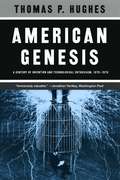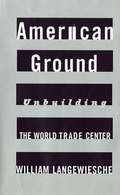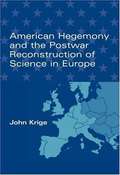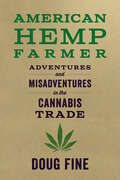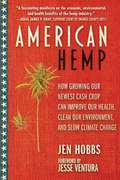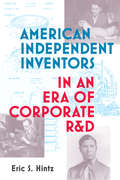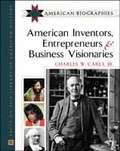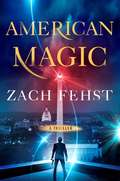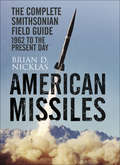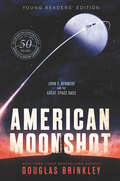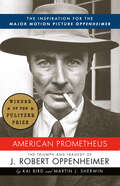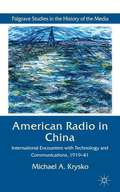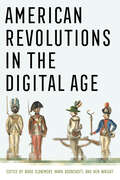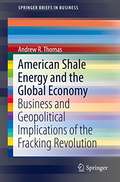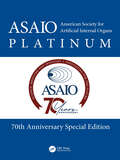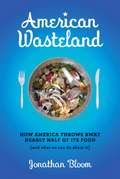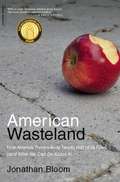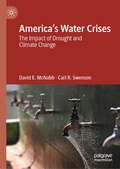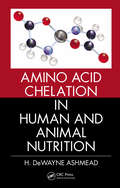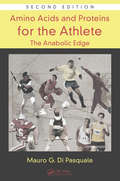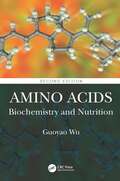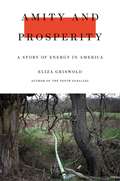- Table View
- List View
American Genesis: A Century of Invention and Technological Enthusiasm, 1870–1970
by Thomas P. HughesThe book that helped earn Thomas P. Hughes his reputation as one of the foremost historians of technology of our age and a finalist for the Pulitzer Prize in 1990, American Genesis tells the sweeping story of America's technological revolution. Unlike other histories of technology, which focus on particular inventions like the light bulb or the automobile, American Genesis makes these inventions characters in a broad chronicle, both shaped by and shaping a culture. By weaving scientific and technological advancement into other cultural trends, Hughes demonstrates here the myriad ways in which the two are inexorably linked, and in a new preface, he recounts his earlier missteps in predicting the future of technology and follows its move into the information age.
American Ground: Unbuilding the World Trade Center
by William LangewiescheAn interesting study of the rescue effort after 9-11 and the attempt to clear away the debris, including the conflict between the fire and policemen.
American Hegemony and the Postwar Reconstruction of Science in Europe
by John KrigeIn 1945, the United States was not only the strongest economic and military power in the world; it was also the world's leader in science and technology.
American Hemp Farmer: Adventures and Misadventures in the Cannabis Trade
by Doug FineThe inside story of the world&’s most fascinating and lucrative crop from gonzo journalist–turned–hemp farmer Doug Fine.Hemp, the non-psychoactive variant of cannabis (or marijuana) and one of humanity&’s oldest plant allies, has quietly become the fastest industry ever to generate a billion dollars of annual revenue in North America. From hemp seed to hemp fiber to the currently ubiquitous cannabinoid CBD, this resilient crop is leading the way toward a new, regenerative economy that contributes to soil and climate restoration—but only if we do it right.In American Hemp Farmer, maverick journalist and solar-powered goat herder Doug Fine gets his hands dirty with healthy soil and sticky with terpenes growing his own crop and creating his own hemp products. Fine shares his adventures and misadventures as an independent, regenerative farmer and entrepreneur, all while laying out a vision for how hemp can help right the wrongs of twentieth-century agriculture, and how you can be a part of it.
American Hemp: How Growing Our Newest Cash Crop Can Improve Our Health, Clean Our Environment, and Slow Climate Change
by Jen HobbsIf there ever was a time to build an American hemp industry, the time is now.In Jesse Ventura’s Marijuana Manifesto, former Minnesota Governor teamed up with Jen Hobbs to explain why it’s time to fully legalize cannabis and end the War on Drugs. Through their research, it became clear that hemp needed its own manifesto. Jen Hobbs takes up this torch in American Hemp.December of 2018 marked a largely unprecedented victory for cannabis. The 2018 Farm Bill passed and with it hemp became legal. What the federal government listed for decades as a schedule 1 narcotic was finally classified as an agricultural crop, giving great promise to the rise of a new American hemp industry. Filled with catchall research, American Hemp examines what this new domestic crop can be used for, what makes it a superior product, and what made it illegal in the first place; the book also delves into the many health and medical benefits of the plant. Hobbs weighs in on how hemp can improve existing industries, from farming to energy to 3D printing, plus how it can make a serious impact on climate change by removing toxins from the soil and by decreasing our dependence on plastics and fossil fuels.American Hemp lays out where we are as a nation on expanding this entirely new (yet ancient) domestic industry while optimistically reasoning that by sowing hemp, we can grow a better future and save the planet in the process.
American Heritage History of Flight
by Arthur GordonPeople dreamed of flight for thousands of years. When we finally took to the skies, a new world opened up. This sweeping, superbly researched history from American Heritage details how various pioneers and innovators - from the Wright Brothers to Chuck Yeager - helped lift us into the sky.
American Independent Inventors in an Era of Corporate R&D (Lemelson Center Studies in Invention and Innovation series)
by Eric S. HintzHow America's individual inventors persisted alongside corporate R&D labs as an important source of inventions.During the nineteenth century, heroic individual inventors such as Thomas Edison and Alexander Graham Bell created entirely new industries while achieving widespread fame. However, by 1927, a New York Times editorial suggested that teams of corporate scientists at General Electric, AT&T, and DuPont had replaced the solitary "garret inventor" as the wellspring of invention. But these inventors never disappeared. In this book, Eric Hintz argues that lesser-known inventors such as Chester Carlson (Xerox photocopier), Samuel Ruben (Duracell batteries), and Earl Tupper (Tupperware) continued to develop important technologies throughout the twentieth century. Moreover, Hintz explains how independent inventors gradually fell from public view as corporate brands increasingly became associated with high-tech innovation.Focusing on the years from 1890 to 1950, Hintz documents how American independent inventors competed (and sometimes partnered) with their corporate rivals, adopted a variety of flexible commercialization strategies, established a series of short-lived professional groups, lobbied for fairer patent laws, and mobilized for two world wars. After 1950, the experiences of independent inventors generally mirrored the patterns of their predecessors, and they continued to be overshadowed during corporate R&D's postwar golden age. The independents enjoyed a resurgence, however, at the turn of the twenty-first century, as Apple's Steve Jobs and Shark Tank's Lori Greiner heralded a new generation of heroic inventor-entrepreneurs. By recovering the stories of a group once considered extinct, Hintz shows that independent inventors have long been—and remain—an important source of new technologies.
American Inventors, Entrepreneurs, and Business Visionaries
by Charles W. CareyFaced with limiting his coverage to less than 300 people, Carey (US history and western civilization, Lynchburg College and Central Virginia Community College) had little trouble including the famous figures that would be expected in such an account. After that, he strove to represent all categories of American life in order to demonstrate that people from all backgrounds have been and therefore can be successful innovators and visionaries in business. Annotation c. Book News, Inc., Portland, OR (booknews.com)
American Magic: A Thriller
by Zach FehstIn this fast-paced, international thriller, chaos erupts after a shadowy figure with ties to an elite and ancient society posts incantations on the dark web that allow people to perform real magic.When an enigmatic message uploaded to the dark web turns out to contain an ancient secret giving regular people the power to do impossible things, like levitate cars or make themselves invisible, American government officials panic. They know the demo videos on YouTube and instructions for incantations could turn from fantastical amusement to dangerous weapon at the drop of the hat, and they scramble to keep the information out of the wrong hands. They tap Ben Zolstra, an ex-CIA field operative whose history with the Agency is conflicted at best, to lead the team that’s racing to contain the dangerous knowledge—and track down the mysterious figure behind the leak who threatens that even more dangerous spells will be released one by one until the world as we know it no longer exists. This sweeping, globe-spanning thriller explores the dark consequences of a question mankind has been asking for centuries: What if magic were real?
American Military Intervention in Unconventional War
by Wayne BertA study of the major U. S. military interventions in unconventional war, this book looks at four wars that occurred while the U. S. was a superpower in the post-war WW II period and one in the Philippines in 1898.
American Missiles: The Complete Smithsonian Field Guide
by Brian D. NicklasThis remarkable guide provides for the first time an illustrated listing of almost 200 of Americas most powerful missiles. With information on all aspects of the missiles specifications, including the speed and capacity of the explosives used in its warhead, this book provides a comprehensive guide to the US Armys projectile hardware. 'American Missiles: The Complete Smithsonian Field Guide' draws heavily on the Herbert S. Desind Photo Collection, a resource of more than 110,000 images recently catalogued at the National Air and Space Museum. Of interest to both the specialist and the aviation enthusiasts, this book demonstrates the evolution of American missile design over the last forty years in an accessible and entertaining format.
American Moonshot Young Readers' Edition: John F. Kennedy and the Great Space Race
by Douglas BrinkleyIn anticipation of the 50th anniversary of the first moon landing, New York Times bestselling author and historian Douglas Brinkley delivers a young readers’ edition of a story rooted in heroism, bravery, and patriotism: America’s race to the moon. July 20, 1969. It’s a day that has earned a spot in history. It’s the day that America was the first nation to succeed in sending two astronauts—Buzz Aldrin and Neil Armstrong—to the moon.But what led to this unforgettable event? What were the stakes riding on the Apollo 11’s safe landing? In acclaimed author Douglas Brinkley’s first young readers' edition, space fans will get the riveting and factual backstory of arguably the most significant achievement of the 20th century.
American Prometheus: The Inspiration for the Major Motion Picture OPPENHEIMER
by Kai Bird Martin J. SherwinTHE INSPIRATION FOR THE MAJOR MOTION PICTURE OPPENHEIMER • "A riveting account of one of history&’s most essential and paradoxical figures.&”—Christopher Nolan#1 NEW YORK TIMES BESTSELLER • PULITZER PRIZE WINNER • The definitive biography of J. Robert Oppenheimer, one of the iconic figures of the twentieth century, a brilliant physicist who led the effort to build the atomic bomb for his country in a time of war, and who later found himself confronting the moral consequences of scientific progress.In this magisterial, acclaimed biography twenty-five years in the making, Kai Bird and Martin Sherwin capture Oppenheimer&’s life and times, from his early career to his central role in the Cold War. This is biography and history at its finest, riveting and deeply informative.&“A masterful account of Oppenheimer&’s rise and fall, set in the context of the turbulent decades of America&’s own transformation. It is a tour de force.&” —Los Angeles Times Book Review&“A work of voluminous scholarship and lucid insight, unifying its multifaceted portrait with a keen grasp of Oppenheimer&’s essential nature.... It succeeds in deeply fathoming his most damaging, self-contradictory behavior.&” —The New York Times
American Radio in China
by Michael A. KryskoInterwar era efforts to expand US radio into China floundered in the face of flawed US policies and approaches. Situated at the intersection of media studies, technology studies, and US foreign relations, this study frames the ill-fated radio initiatives as symptomatic of an increasingly troubled US-East Asian relationship before the Pacific War.
American Regulatory Federalism and Telecommunications Infrastructure (LEA Telecommunications Series)
by Paul TeskeDuring this era of construction of the information superhighway, this volume presents a prudent analysis of the pros and cons of continuing state regulation of telecommunications. While interested parties either attack or defend state regulation, careful scholarly analysis is required to strike the appropriate balance of regulatory federalism. Focusing on regulation in the 1990s, it uses a positive political economy perspective to analyze enduring state-federal conflicts and to weigh the justifications and explanations for continuing state telecommunications regulation, or for changing its structure. It also considers normative concerns and makes recommendations about how to improve telecommunications policy. Seriously concerned with assessing the problems surrounding cost burdens for different categories of consumers, market entry for different firms, economic growth and the information infrastructure, global competitiveness, and control over information, this volume attempts to provide answers to the following specific questions: * How are states regulating telecommunications in the brave new world of global markets, fiber optics, and digital technology? * Do states vary significantly in their regulatory models? * How are the politics of state and federal regulation different? * Would a different federal-state relationship better serve national telecommunications goals in the future? To tackle these critical questions, the scholarly perspectives of economists, lawyers, political scientists, and telecommunications consultants and practitioners are employed.
American Revolutions in the Digital Age
by Ben Wright Mark Boonshoft Nora SlonimskyThe interdisciplinary essays in American Revolutions in the Digital Age explore what digital tools can tell us about the late eighteenth- and early nineteenth-century United States and reveal how an understanding of the American past can make sense of our digital present. By employing a host of innovative digital research methods, these authors challenge long-held assumptions about the American past. In addition, this collection uniquely demonstrates how contemporary anxieties about an array of topics, including media disinformation, patriarchy, economic inequality, and public memory, can be better understood through careful considerations of early American history.Open Access edition funded by Iona University
American Shale Energy and the Global Economy: Business And Geopolitical Implications Of The Fracking Revolution (SpringerBriefs In Business)
by Andrew R. ThomasProvides a rational, comprehensive overview of the major business themes and management implications of the new abundance of natural gas in the U.S.<P><P> Explores the hopes and hazards posed by natural gas extraction techniques (i.e., fracking).<P> Examine the ways shale energy impacts supply chains for firms.<P> Identifies significant geopolitical consideration surrounding the rise of shale energy.<P> This brief explores the business and global implications of the American shale energy, or natural gas, revolution. Specifically, it provides a rational, comprehensive look at the major business themes and management implications that surround the new abundance of natural gas in the United States and identifies some of the most significant geopolitical considerations globally. While acknowledging some of the controversies and hazards surrounding the extraction techniques, commonly known as “fracking”, the author also looks at the hopes this technique poses and details how shale energy will impact supply chains for firms. <P> The discovery of new sources of domestic natural gas in recent years - coupled with innovations that facilitated their extraction - has altered the global landscape. However, the vast majority of the information out there for business students, faculty, and practitioners about the natural gas revolution is focused on the impact of “longer and lower” energy prices; and, secondarily, opportunities within the domestic energy sector. Each of these is crucial for business people to understand, however, the natural gas revolution is about much more. Companies of all sizes, whether they see it or not, are having new opportunities open up for their products and services. Further, the globalization of shale energy will have far reaching influence beyond simply economic factors. Geopolitical considerations and the re-structuring of international relations around shale energy will impact supply chains in a myriad of ways. This book aims to examine these opportunities.<P> Featuring case studies from contemporary companies, this book will be of interest to students, academics, researchers, professionals and policy makers who are seeking to understand the business and global implications of the shale energy revolution.
American Society for Artificial Internal Organs (ASAIO) Platinum 70th Anniversary Special Edition
by Pramod BondeThis book celebrates two decades of groundbreaking research published in the ASAIO Journal, marking significant advancements in artificial organs and circulatory support.The American Society for Artificial Internal Organs ASAIO Platinum 70th Anniversary book is a compilation of 50 of the top papers published in the ASAIO Journal over the last two decades that have contributed to the evolution of the field. The book includes tables listing the Top 100- cited, viewed, and downloaded, articles from the ASAIO Journal. It also lists the Top 10 Altmetric Scores by Year, 2015-2024. Topics range from artificial vision for the blind, and control systems for blood glucose, to the development of an artificial placenta IV and engineering 3D bio-artificial heart muscle, and much more. This book represents early ideas and concepts, new treatments and devices that changed future clinical care and some early concepts that challenge the status quo. With contributions from leading experts, the ASAIO 70th Anniversary Book serves as a comprehensive resource for anyone interested in the forefront of artificial organ technology and its impact on improving patient outcomes.This book is intended for clinicians, scientists, engineers, and academics working for the advancement and development of innovative medical device technologies.
American Wasteland
by Jonathan BloomThe "Traffic" and "Affluenza" of food waste: an eye-opening account of our culture of excess and waste?and what we can do to change it
American Wasteland: How America Throws Away Nearly Half of Its Food (and What We Can Do About It)
by Jonathan BloomThe Traffic and Affluenza of food waste: an eye-opening account of our culture of excess and waste--and what we can do to change it
America’s Water Crises: The Impact of Drought and Climate Change
by David E. McNabb Carl R. SwensonThis book is focused exclusively on water problems in the 48 U.S. states. The authors provide an accessible overview of the work of many federal, state and academic researchers and water system administrators whose investigations have focused on the state of water and the water crisis now accelerating in the United States. David McNabb and Carl Swenson seek to bring to a wider audience some of the current research findings and data on the perilous state of the United States’ surface and groundwater resources during this time of climate change and the extreme drought taking place in many sections of the nation. Descriptions of the water resource systems are based on research and the subsequent findings published by water scientists in the United States Geological Survey, the Environmental Protection Agency, the U.S. Corps of Engineers and water related agencies of the Departments of Agriculture and of the Interior and state and local water management agencies.
Amino Acid Chelation in Human and Animal Nutrition
by H. DeWayne AshmeadAlthough introduction of amino acid chelates in mineral nutrition initially met considerable skepticism and controversy, the greater absorption and bioavailability of amino acid chelated minerals compared to nonchelated minerals have been well-documented for decades. Amino Acid Chelation in Human and Animal Nutrition compiles published chemical, nu
Amino Acids and Proteins for the Athlete: The Anabolic Edge (Nutrition in Exercise & Sport)
by Mauro G. Di PasqualeExtensively updated with all chapters rewritten and double the information and references, Amino Acids and Proteins for the Athlete: The Anabolic Edge, Second Edition reflects the nearly exponential increase in data and knowledge in the past few years regarding the use of amino acids and proteins to enhance athletic performance. This groundbreaking
Amino Acids: Biochemistry and Nutrition
by Guoyao WuFollowing its predecessor, the second edition of Amino Acids: Biochemistry and Nutrition presents exhaustive coverage of amino acids in the nutrition, metabolism and health of humans and other animals. Substantially revised, expanded and updated to reflect scientific advances, this book introduces the basic principles of amino acid biochemistry and nutrition, while highlighting the current knowledge of the field and its future possibilities. The book begins with the basic chemical concepts of amnio acids, peptides and proteins, and their digestion and absorption. Subsequent chapters cover cell-, tissue-, and species-specific synthesis and catabolism of amino acids and related bioactive metabolites, and the use of isotopes to study amino acids metabolism in cells and the body. The book details protein turnover, physiological functions of amino acids, as well as both the regulation and inborn errors of amino acid metabolism. The book concludes with a presentation on human and animal dietary requirements of amino acids and evaluates dietary protein quality. Features: Encompasses a comprehensive coverage of basic to applied concepts in amino acid metabolism in humans and other animals. Highlights important roles of dietary amino acids and protein intake in growth, physical performance and health, including sarcopenia mitigation and immunity. Discusses concerns over the excess intakes of amino acids or protein in the development of diseases, including cardiovascular disorders, diabetes and cancers, as well as bone integrity Each chapter contains select references to provide comprehensive reviews and original experimental data on the topics discussed. Each chapter is backed by original experimental data on various topics discussed and contains select references to aid the reader further in research. Written by Distinguished Professor of Animal Nutrition, Guoyao Wu, Ph.D., this book is an authoritative reference for students and researchers in both biomedicine and agriculture.
Amity and Prosperity: One Family and the Fracturing of America
by Eliza Griswold<p>In Amity and Prosperity, the prizewinning poet and journalist Eliza Griswold tells the story of the energy boom’s impact on a small town at the edge of Appalachia and one woman’s transformation from a struggling single parent to an unlikely activist. <p>Stacey Haney is a local nurse working hard to raise two kids and keep up her small farm when the fracking boom comes to her hometown of Amity, Pennsylvania. Intrigued by reports of lucrative natural gas leases in her neighbors’ mailboxes, she strikes a deal with a Texas-based energy company. Soon trucks begin rumbling past her small farm, a fenced-off drill site rises on an adjacent hilltop, and domestic animals and pets start to die. When mysterious sicknesses begin to afflict her children, she appeals to the company for help. Its representatives insist that nothing is wrong. <p>Alarmed by her children’s illnesses, Haney joins with neighbors and a committed husband-and-wife legal team to investigate what’s really in the water and air. Against local opposition, Haney and her allies doggedly pursue their case in court and begin to expose the damage that’s being done to the land her family has lived on for centuries. Soon a community that has long been suspicious of outsiders faces wrenching new questions about who is responsible for their fate, and for redressing it: The faceless corporations that are poisoning the land? The environmentalists who fail to see their economic distress? A federal government that is mandated to protect but fails on the job? Drawing on seven years of immersive reporting, Griswold reveals what happens when an imperiled town faces a crisis of values, and a family wagers everything on an improbable quest for justice.</p>
